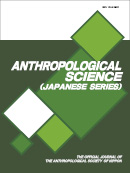All issues

Volume 122 (2014)
- Issue 2 Pages 133-
- Issue 1 Pages 1-
Volume 122, Issue 2
Displaying 1-4 of 4 articles from this issue
- |<
- <
- 1
- >
- >|
Original Article
-
Hiroyuki Yamada, Yuzuru Hamada, Yutaka Kunimatsu2014Volume 122Issue 2 Pages 133-143
Published: 2014
Released on J-STAGE: December 19, 2014
Advance online publication: August 23, 2014JOURNAL FREE ACCESSWe aimed to describe crown morphology and sexual dimorphism of the canine in the Hylobates lar. As have been reported in the previous studies, the canines of male and female Hylobates lar were nearly the same in morphology as well as in size. Viewed from the buccal aspect, the contours of maxillary canines of both sexes had a saber-like form, while those of the mandibular canines had a quadrilateral form. However, the results in the present study indicated that sexual dimorphism in the canines of Hylobates lar was slightly but definitely found, not only in the size but also in the shape and structure of the canine teeth. Compared with the male canines, the female canines were characterized as follows: 1) smaller in whole size, 2) the crown reliefs, such as grooves and ridges, were less developed, which gave blunt and roundish appearance, 3) the mesial shoulder of mandibular canine was located relatively higher toward the cusp tip, 4) the cervical ridge was more developed. Odontmetrically, male canines were significantly larger in the basal crown size and higher in crown height. Crown heights in upper and lower jaws, especially the distance from the cusp tip to the mesial shoulder were also greater in males than females. On the other hand, the enamel bulge of cervical portion relative to maximum diameter of the mandibular canine crown was significantly stronger in female. Moreover, the mesial shoulder in female located as high as middle of the crown height; the average relative distance between mesial shoulder and cervical line in male was 32.8% of the crown height, while 48.1% in female. The degree of canine sexual dimorphism in Hylobates suggests that sexual differences are present even in the paired-social group, which may suggest male male competition in Hylobates lar.View full abstractDownload PDF (1128K)
Material Research Reports
-
Cranial characteristics of Bunun tribe from Mayuan village, Wanrung township, Hualien county, TaiwanMasami Takenaka, Pei-Ying Tsai , Hsi-Kuei Tsai, Kuo-Shyan Lu2014Volume 122Issue 2 Pages 145-155
Published: 2014
Released on J-STAGE: December 19, 2014
Advance online publication: September 17, 2014JOURNAL FREE ACCESSDetailed data of cranial and facial flatness measurements of modern Bunun aboriginal tribe of Taiwan were presented in this study. Bunun crania are characterized by their mesocranic and low cranial vaults as well as their slightly high facial skeletons with the less flat frontal regions in comparison with several modern samples from Taiwan, northeastern and southeastern Asia, and Pacific area. As for Penrose shape distances on nine cranial measurements (maximum cranial length, maximum cranial breadth, basion-bregma height, bizygomatic breadth, upper facial height, orbital breadth, orbital height, nasal breadth and nasal height), Bunun shows a close affinity to Paiwan tribe of Taiwan. However, Yami indicate the quite difference from Bunun in Taiwan aboriginals.View full abstractDownload PDF (1524K) -
Noboru Adachi, Kazuo Umetsu, Minoru Yoneda, Toshihiko Suzuki, Takashi ...2014Volume 122Issue 2 Pages 157-166
Published: 2014
Released on J-STAGE: December 19, 2014
Advance online publication: October 16, 2014JOURNAL FREE ACCESSIn the present study, we performed detailed personal identification of the two molars unearthed from the Shitsukari-Abe cave in Aomori, Japan. By morphological analysis, each molar was identified as left lower third or second molar and right upper second molar, respectively. Both of the molars were subjected to stable isotope ratio analysis, and their carbon and nitrogen isotopic ratios were very similar. Direct 14 C dating of these samples resulted in 4286–4080 calBP (68.2%) and 4280–4080 calBP calBP (68.2%), respectively. MtDNA sequences of the molars were identical, and were designated to haplogroup D4h2, which is observed in Hokkaido Jomon people and present-day Ulchi people inhabiting lower Amur region of Siberia. STR analyses could be successfully performed for both specimens in all regions examined, and the results were identical. By combining the results of the analyses described earlier, it is highly possible that these two molars were derived from the same individual. This is the first case in which Jomon skeletal materials that have lost their anatomical articulations were securely confirmed to be originated from the same individual.View full abstractDownload PDF (1242K)
Miscellaneous Report
-
Yastami Nishida2014Volume 122Issue 2 Pages 167-175
Published: 2014
Released on J-STAGE: December 19, 2014
JOURNAL FREE ACCESSIn 1924, Dr. Yoshikiyo Koganei, the first Japanese physical anthropologist, conducted an excavation at the Kasori shellmound. A brief site report was made by Ichiro Yawata, but its final report had not been published since then. Recently the author discovered Koganei’s fieldnote in which the details of the excavation is recorded. The process of the excavation from its planning to the post-excavation research is now revealed. The record tells the details as to the negotiations with the land owners and the expenses. In the early stage, the excavations in Japan was not systematic and more like treasure hunting. In the 1920’s gradually the more organized excavation methods began to be applied. This record is important in this regard as well.View full abstractDownload PDF (2229K)
- |<
- <
- 1
- >
- >|